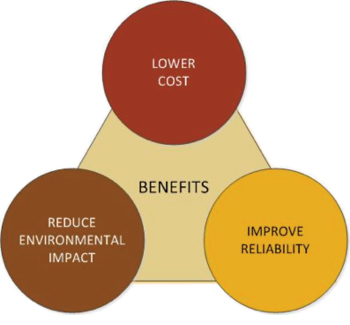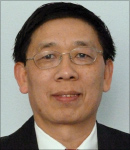The term ‘Smart Grid' has been used over the past decade to include a number of disparate ideas related to making the electricity grid more reliable, more economic, or more environmentally friendly. One of these ideas is that end-use customers should move from flat or time-of-use electricity rates to real-time pricing models that change based in part on what is happening to real-time electricity rates at the wholesale level. One can make arguments that if executed properly, more accurate pricing would lower costs, support more renewable resources, and ultimately balance load to improve overall grid reliability (Figure 1). But when these long-term gains require that customers spend money, invest time, and even experience lower levels of comfort, what objectives should future responsive demand programs achieve so that customers will make these short-term sacrifices?
Most electricity consumers fall into a group which can be called ‘passive customers.’ Passive customers, as the name implies, do not actively participate in understanding the complexities of electricity. Rather, they simply plug in their devices and get a bill, and occasionally call the local utility if there is a disruption in service. A good parallel to the passive electricity customer is an employee with a 401k plan who contributes a percentage of his salary into a mutual fund and rarely (or perhaps never) adjusts the financial portfolio.

Figure 1: Key benefits of smart grid and demand response include a more reliable,
more economic, and more environmentally friendly grid.
The other case which has become fashionable to discuss in recent years is the ‘active customer.’ Enabled by an increasingly networked life, the active electricity consumer can monitor conditions in the home, view status information of household devices, and follow the trends of, and the predictions for, the price of electricity. The active customer then optimizes this information into a plan for devices, be that cycling an air conditioner, delaying a dishwasher load, or dimming the lights. The parallel here is the employee who frequently examines his investment portfolio, researches market trends, and trades stocks in an attempt to optimize the financial outcomes.
The Internet has enabled individual consumers to play more active roles than ever before in managing both their financial portfolios and electric devices. But easy access to information is only part of the solution; it is important that the information be standardized to make it easier to understand and to enable software developers to build tools to effectively leverage it. Like common financial industry terminology and standard data feeds, a consistent model and information delivery framework is necessary for electricity grid information. The investment portfolio analogy provides half the picture; the other half is access to near real-time electrical usage data as well as historical trends and behaviors.
This information about the consumer and his electrical devices must be captured in a standard format with proper safeguards to protect the customer’s privacy.
Incentive to Become Active
So when the information does become available in a standard and secure format, what is the incentive for a passive electricity customer to become an active electricity customer? The incentive for the active portfolio management is clear; there is the potential for substantial financial gains to be realized by putting more effort into the process. Is the incentive the same for the electricity customer?
Consider a customer with a 10 kilowatt air conditioning compressor equipped with a device which can operate the unit at a 50 percent duty cycle for the most expensive 100 hours of the year, a net reduction of 500 kWh. If this customer lives in the PJM territory and was buying power at wholesale prices in 2011, the average rate of energy costs in those peaks hours would have been 17 cents per kWh, yielding an annual net savings of $85.
The customer could add more devices into the scheme such as a water heater and a pool pump, even a refrigerator or a space heater, but all of these loads are generally smaller and in some configurations the discomfort for customers will clearly outweigh the financial incentive. The catch is the more people who implement demand response in this way, the more the peak prices are suppressed by the aggregate load reduction, and lower the effective individual savings becomes over time. So other factors held constant, this example of the above annual savings can be viewed as a best case scenario.
For loads which can change their level of electricity consumption quickly, providing ancillary services can add even more value. Ancillary services include making small increases or decreases in electricity consumption to keep electricity supply and demand in balance (regulation service) and being able to provide larger reductions in the event of short-term supply deficiency (reserve service). PJM members paid $234 million in 2011 for regulation services and another $579 million for operating reserves. Using a simple average load ratio share1,2, every residential customer’s contribution in the territory was approximately $12. So even if every customer could cover his own portion of these support service costs, the individual savings here too are small.
If cost savings is not the answer, what is?
Technology Enablers
Energy efficiency of residential refrigerators has steadily and drastically improved over the years – a phenomenon which is largely invisible to the public. While the average refrigerator size has increased, energy usage today is approximately five times more efficient compared to levels just three decades ago.3 Why has efficiency improved? The simple answer is technology: better insulation, new refrigerants, and more efficient compressors with improved cooling cycles. But customers didn’t demand these technologies directly; public awareness through consistent energy efficiency labeling and ever-improving Federal efficiency standards along with tax rebates and purchase incentives meant that manufacturers needed to use these technologies to be competitive in the marketplace.
This is a success story where passive customers are involved: buy a refrigerator with a good rating and the role of the customer is essentially complete. And, in fact, it represents a success for all three of the benefit areas: less power consumption means reduced energy cost, plus a less stressed and more environmentally friendly grid. There are many things that both consumers and policy makers can do – with help from new technologies – that will bring more benefits. Most importantly, the simplest things do not require all of us to become active customers, nor to invest our time, to spend our money, or to sacrifice our comfort in any meaningful way.
Today, devices are relatively ignorant of electricity grid conditions. But there are signals that could be broadcast to augment any conditions which can be monitored locally to facilitate future devices to help our grid and our bottom line at the same time. For example, consider a freezer which is capable of processing the following rudimentary signals (Table 1). These actions would barely be noticed by the typical consumer, and the aggregate load benefits could be significant when implemented in scale.
|
Signals & Sensors |
Automatic Actions |
|
Reduce temperature setting a small amount for a small period of time and delay defrost cycle several hours. |
|
Increase temperature setting a small amount for a small period of time and perform defrost cycle if required. |
Table 1. Smart Freezer: Processes Signals and Takes Automatic Actions
Other response schemes could be automatically programmed into devices. If one considers air conditioning compressors, hot water heaters, pool pumps, resistive heating, clothes dryers, dishwashers, and electric vehicle charging, it is conceivable that these new smart loads could supply some or all of the reserve requirements for the bulk power system, and perhaps even a major portion of the regulation and frequency support functions. The costs for these types of functions might very well be covered by reduced system support costs well before the life of the device runs out.
Grid price signals may come from multiple sources and have different levels of granularity. Electricity prices may be stable over large areas or zones or vary down to the nodal level. The prices may also have components from different sources too, including core information from the wholesale markets, overriding or supplemental components from a load serving entity, and adders from the distribution operator.
Grid health signals could also come from multiple sources. The transmission system operator could warn of low reserve margins and a distribution operator could warn of a feeder overload. With large scale renewables on the transmission system with unpredictable generation levels and with distributed generation on the rise, the chances for these types of problems will increase. There are also unique scenarios where transmission and distribution health signals can oppose each other or at times the health signals move load opposite in direction to the effects from price signals.
Putting all of this together, the need for sophisticated software to properly process these data – in a standard format – becomes obvious.
Making It Happen
Standard Signals: First and foremost, the industry must quickly converge on a set of common signals for communicating the value of electricity along with an indication of the health status of the grid. These messages should be very small, very simple, and identical across all regions.
It may be useful to publish multiple forms of the information, for example zonal or local nodal prices as well as qualitative prices such as high/medium/low relative to historical norms. System health should also be communicated, akin to the Department of Homeland Security Advisory System – simple levels for well-defined conditions. Giving the device manufacturers multiple options will help them to innovate. The flip-side is that these standards will need to be extendable and be allowed to be improved over time as experience increases.
Incentivize Adoption: As noted, the cost savings alone to customers may not be enough to create this mindset change. If demand response providers and load-serving entities don’t see a play to scale up the proceeds and push it forward, we might consider either a carrot approach (a reduced electricity rate or a discount on the purchase of an enabled appliance purchase) or a stick approach (an opt-out fee or an increased electricity rate) can be used. Government action can help solve part of the problem, nudging manufacturers to enable their devices – just as we have seen with the refrigerator efficiency standards. For example, it is not unreasonable for the owner of a plug-in electric vehicle who now stresses the grid more than the average customer to use his vehicle to help support that grid with some level of regulation and reserve service.
Public Awareness: Every consumer has his or her own personal spin on which component is most important: cost, reliability, or environmental responsibility. Regardless of that preference, the goals are not mutually exclusive. Public awareness campaigns that focus on all three points over time are essential, for example:
- Buy this grid-enabled device today, and the investment will pay for itself
- Buy this grid-enabled device today, and you are helping to reduce the chances of a power outage and you will helping restore power when it does go out
- Buy this grid-enabled device today, and you will be helping to balance wind turbines when the wind dies down and solar panels when clouds pass overhead
In the end, some people are excited to become active electricity customers. The good news is that none of these ideas are inconsistent with someone who wants to increase the responsiveness of the devices in the home. In fact, having a common set of signals, extra financial incentives, increased public awareness and, more importantly, devices which are smart enough to go beyond ‘plug it in and walk away,’ means that becoming that active electricity customer is a much easier job.
But many of us will not want to choose this path. We should all understand that as a society we have become much more demanding of our electricity grid and the signs point to our demands rising in the future. If we do not become active electricity customers, perhaps it is our obligation to actively push to become a new kind of passive electricity customer: one with responsive devices which support our electricity grid in simple but very meaningful ways.
A Future View of Responsive Load Signals
Signals for controlling electrical loads fall into two major groups:
- Command-and-control style signals used for traditional demand response
- Broadcast style signals used to publish information about the grid.
While the latter signals are integral to the success of responsive loads, the former are the most highly evolved today.
Demand response has developed organically over many years. Without central oversight, programs were designed with bespoke control signals; in other words one program’s control signals were generally independent from every other program’s signals. Today, there are options which can be utilized instead of creating yet another protocol from scratch. The first is OpenADR, a protocol with several practical implementations and heavy backing from a number of important industry players through the recently formed OpenADR Alliance.
The Independent System Operators (ISOs) and Regional Transmission Organizations (RTOs) in North America took a slightly different approach from Open Automated Demand Response (OpenADR) and developed a second option in recent years. Utilizing the standards development processes at the North American Energy Standards Board (NAESB), an initial model for demand response signals was developed and published in 2010. The ISOs and RTOs took another step forward as they evolved that standard into an International Electrotechnical Commission (IEC)-based model in late 2012, building upon the existing, widely used IEC standards. Currently, working groups at the IEC are bringing this standard into the core IEC models for electrical power systems.
As we embark on developing those broadcast style signals for responsive loads, there are several influences which should be considered: there are components within the aforementioned IEC models which can be leveraged and there is also a base model available from NAESB on the topic. A sure-fire recipe for successful responsive load signals should include a solid analysis of these sources including input from grid operators, device manufacturers, and consumer advocacy groups, an open process for public comment, and a liberal amount of experimentation and testing.
1 Annual load in PJM is approximately 778,000 GWh (PJM 2011 Annual Report)
2 Annual residential utility customer usage is 11.5 MWh (U.S. Energy Information Administration http://www.eia.gov/tools/faqs/faq.cfm?id=97&t=3)
3 http://www.appliance-standards.org/sites/default/files/Refrigerator_Fact_ Sheet_Aug_25_2011.pdf
About the author
 Dr. Scott Coe is a Vice President at UISOL and manages UISOL’s Markets & Demand Response practice. His industry contributions include co-chairing the NIST working group for the Wholesale Demand Response Communication Protocol and facilitating the ISO/RTO Council’s development of the NAESB DR measurement and verification standard. Scott holds an MS in Engineering Physics and a PhD in Physics. He can be reached at scoe@uisol.com.
Dr. Scott Coe is a Vice President at UISOL and manages UISOL’s Markets & Demand Response practice. His industry contributions include co-chairing the NIST working group for the Wholesale Demand Response Communication Protocol and facilitating the ISO/RTO Council’s development of the NAESB DR measurement and verification standard. Scott holds an MS in Engineering Physics and a PhD in Physics. He can be reached at scoe@uisol.com.
 Dr. Shangyou Hao is is a Director at UISOL. He has over 25 years of experience in power system engineering, economics, computer applications and systems integration services in the utility industry. Shangyou received a PhD in Electrical Engineering and can be reached at
Dr. Shangyou Hao is is a Director at UISOL. He has over 25 years of experience in power system engineering, economics, computer applications and systems integration services in the utility industry. Shangyou received a PhD in Electrical Engineering and can be reached at
shao@uisol.com.







